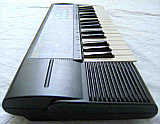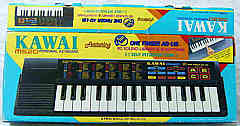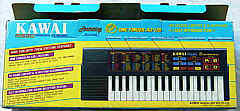| small digital keyboard with built-in complex music patterns & impulsive rhythms |
This quite rare instrument seems to be the only halfway toy- like keyboard released by Kawai.
 |
 |
This keyboard was also released as Kawai MS30 (changed panel print with green instead of blue, ultra-rare, seen on US eBay).
 |
 |
AC- adapter jack polarity changed to standard
sound output jack + speaker mute switch added keyboard matrix bug fixed (was polyphony mess with empty battery =>18 kOhm pullup resistors soldered from matrix inputs against +5V)
Initially there was a polyphony bug that made note mess with empty batteries due to crosstalk on the keyboard matrix; solder from each key input an 18 kOhm pullup resistors against the +5V supply voltage of the IC LC7881 to fix this. (The 5V voltage there is controlled by the electronic power switch; using a voltage before the switch would empty the batteries through the resistors when not in use.) The power amp seems to be a bridge amplifier, but as usual also here a 100nF capacitor from the speaker "+" pin to the output jack works well. Strange is that the Kawai TC531000CP chip (ROM?) has 28 pins while on the PCB are 4 additional holes to support here also a 32 pin IC.
The main voice preset sounds are made from 2 mixed medium resolution samples. While most sounds have only a simple (ADSR?) envelopes, the effect sounds use complex algorithmic envelopes, but unfortunately all but 1 play the same note on all keys. The main voice sounds are much cleaner but less complex than on Casio SA-1; especially they contain neither reverb nor echo effects. Unlike the bigger Kawai MS720 most employ simple waveform samples, and the bright ones sound harsh although not rough (possibly by a hissy speaker or amp). Most sounds resemble simple 2 operator FM timbres, but regarding the limitations of static waveform samples, most timbres are fairly realistic. In the following I will only describe unusual or unnatural sounding presets, and when not otherwise mentioned they employ waveform samples. The "pan flute" sample (selected after power- on) starts with a hissing wind (breath) noise; it is the only sound that starts this way. "flute" has vibrato. Most other wind instruments have a percussive attack phase (like an old, envelope- less electronic organ). "trumpet 1" sounds realistic, while 2 has a slow attack rate and rather resembles a harsh violin ("violin" has additional vibrato). "trumpet duo" sounds static like a single trumpet; only its attack phase sounds like 2 trumpets. "toy trumpet" instead has a more noticeable chorus, a quite percussive attack and sounds duller than "trumpet 1". "fat brass" 1 is a thinner(!) sounding synth brass chorus that resembles the famous Casio SA-1 "brass ens" (but thin like its "trumpet") while 2 has a slow attack phase and thus resembles a harsh violin ensemble ("strings" is similar with sustain). The pianos are made from static waveform samples without chorus and thus unrealistic. "piano" 2 is slightly duller than 1, "honky tonk" has detuned chorus. "e. piano" 1 resembles a Rhodes piano, 2 has additional chorus. "ef. piano" is another, quite dull piano with harsh bass range by low sample resolution. Both harpsichords sound of banjo. "jazz organ" is a clean Hammond organ sound, "drawbar 1" another one, 2 is harsher. "rock organ" is a creakier timbre with vibrato. "vib organ" 1 & 2 resemble "drawbar" with vibrato. "x fade" is a brighter fading metal pipe organ (like a Casio Consonant Vowel timbre). The strings sound quite cold; the bass range of "cello" could be also a harsh horn timbre. "koto" has vibrato. "glass solo" is a tooting glassy organ timbre with percussive attack phase (could be also a harsh telephone tone). "sequence" is simply a harsh, low and buzzy picked string (like a mandolin); "hard clavi" and "tine clavi" sound similar but with longer sustain phase. "rock clavi" has additional vibrato. "tubular bell" has chorus and the timbre resembles more a hollow picked string (banjo?). "orient bell" is quite harsh (like a My Music Center sound), "tine bell" is bright and very percussive, "small bell" even brighter. "glass harp" is a bowed glass. "wine glass" resembles a musicbox with additional strong vibrato. "cosmic" 1 resembles a harsh metallic e-piano with sustain, 2 has a slow attack rate and resembles a bowed glass and fades silent, 3 is like 2 with strong vibrato (or a glassy violin). "a. guitar 2" is like 1 with chorus. "guitar duo" doesn't sound like 2 separate guitars but more like an e-bass (on FM synth?). "vib guitar" is an acoustic guitar with vibrato. "e. guitar" is harsh and somewhat sitar- like (dry bass range). Also "funky bass" is harsh and percussive with buzzy, creaky bass range. "xylophone" is a bit harp- like. "glocken" is glockenspiel. "gamelan" more a vibraphone without vibrato (unlike Casio SA-1 without disharmonic overtones nor special tone scale). "steel drum" has a too soft bass range (rather an e-bass). "soft mallet" & "hard mallet" are also xylophones.
The effect sounds except "invader" only play the same note on all keys, but you can make a phasing effect by pressing multiple keys. "car" is a car horn, "alarm" a high toot with fast purring tremolo (like a phone toot?), "police" alternatingly switches with 2Hz between a brassy tooting tone and a semitone higher. "gun" is a squarewave based historical videogame sound effect that goes "doenng!" in a buzzy way (like a POKEY shift register noise effect). "invader" is a fast up and down bubbling, siren- like pattern that is melodically playable although it sounds not very melodic. "telephone" is a digital phone ring sound (2 fast alternating tones). Applause is what the name suggests (or frying eggs?) and fades silent. (But for tekkno effect sounds a Casio SA-35 is more interesting.)
The "drum set" preset is a drum kit mode with 15 acoustic percussion sounds: {base, rimshot, snare, closed cymbal, high snare, hihat, low tom, mid tom, low conga, high tom, high conga, crash cymbal, tambourin?, gong}, those repeat in the same order on higher keys (play 2x same sound for phasing). The congas sound a bit electronic and the gong is likely the down pitched "crash cymbal" sample. (I named the sounds by ear; they are not listed in the manual.) Unlike Kawai MS720 the percussions don't sound dull but are quite bright, clear and impulsive sounding medium quality samples.
The accompaniment (started with "auto" button) has a fingered and single finger (press "auto" 2nd time) chord mode, but only accepts a few standard chords. The accompaniment styles are complex orchestrated and always use an individual intro and ending; every 8th patterns they automatically insert a fill-in, which can be also confusing. (At least the ending can be skipped by quickly pressing start/stop twice. The Kawai MS720 had a manual fill-in button instead and rhythm could be started and stopped without intro/ ending.) With rhythm off, the accompaniment section plays a manual chord, which timbre depends on the selected rhythm. When the "one finger ad-lib" button is pressed, the keys in the middle keyboard section play each a looped music pattern (monophonic note sequence, some contain volume changes). The music style depends on the selected rhythm. When accompaniment is started, it automatically plays a pre- programmed chord sequence in this mode until the player plays own single finger chords (or presses "one finger ad-lib" twice); with accompaniment the one finger ad-lib pattern plays always in the key of the current accompaniment chord. Each pattern starts as soon its key is pressed and stops as soon it is released. Unlike a groovebox it unfortunately does not sync by itself to the rhythm and they also can not be combined to play multiple tracks simultaneously. Although this thing was clearly not designed for tekkno, it makes still fun to abuse e.g. the "march" and "polka" rhythms in this mode to play in a Doop-like electronic steamjazz style. Unfortunately there are no separate volume controls for the individual tracks, and unlike Kawai MS720 the one finger ad-lib always starts the rhythm and can not be used without. The patterns each select its own main voice sound unless the player selects his own (switch one finger ad-lib off and on again to return to automatic selection). In the rightmost keyboard section the player can still play manually (with the preset sound selected by the pattern when no manual sound selected), although it is less than an octave and thus of little use. Interesting is that with "auto" the accompaniment (but not rhythm) can be turned off (plays main voice notes in chord section). Selecting with the ad-lib now an effect sound makes nice tekkno patterns. Also the 'drum set' turns into interesting drum solos; the selected chords here change the patterns because they apparently get internally translated into note numbers (i.e. different percussion instruments) instead of pitch change commands.
The demo is a complex orchestrated medley:
| removal of these screws voids warranty... | ||
 |
||
|
|